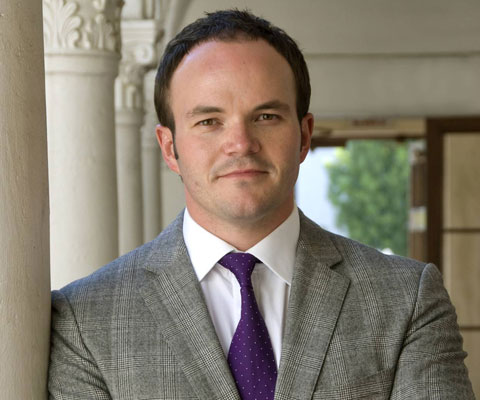
Christopher Bedford, the 35-year-old chief curator of exhibitions at the Wexner
Center for the Arts at Ohio State
University, has been named the next
director of the Rose Art Museum at Brandeis University. He will be the museum's first
director since then school president Jehuda Reinharz and other Brandeis leaders
threatened to close the Rose and sell off its fabulous collection in January
2009 and pushed out then director Michael Rush that summer. Bedford is expected to
begin work on Sept. 15.
Bedford has been at the Wexner
since late 2008, and organized the blockbuster, touring Mark Bradford
retrospective that appeared at Boston's
Institute of
Contemporary Art in 2010.
He's also been doing work with Chris Burden-including editing a planned
collection of Burden's writings for MIT Press-and says he will likely do
something with Burden here. Which suggests that the Rose is on a path to once
again be a curatorial powerhouse in the region-and nationally.
Bedford says the
positive resolution of that threat to the Rose, with the preservation of the
collection and with Brandeis reemphasizing the museum, presents an opportunity.
"It resolved itself in exactly the right way, which struck everybody and me in
particular as a victory," he says. He sees a chance to capitalize on the
international attention the fight brought to Rose.
Bradford says he was attracted to the Rose by the
chance to work with and build a collection ("my God, the collection is
amazing"), the opportunity to continue to work in an university environment, and
his impressions of the university leadership, particularly Provost Steve
Goldstein and President Frederick M. Lawrence, whom he found to be "extremely
passionate about the role of art on a university campus .... There wasn't a
question in my mind about the direction of the
institution."
Brandeis adds that "his goals include
commissioning of a major work of public sculpture outside the museum, expanding
the facility and making the Rose a destination point for social activity both on
campus and in the region."
Bradford would like to include
faculty in the development of exhibits and foster seminars around Rose
programming. He says he aims to keep part of the Rose's collection on view at
all times, in rotating selections, including in depth features on single
artists. He aims to continue expanding the collection, building on its strengths
in of post-World War II American painting in particular by using the Rose's
existing collection funds to buy contemporary abstract painting from the
United States and Europe. Also he hopes to attract donations of vintage
Modernist art to "shore up the core."
Asked whether he plans to hire a curator,
Bradford didn't rule it out, but said, "I want
to pursue a slightly more unorthodox structure that would include adjuncts and
contract-based curators." He says he seeks a broader curatorial voice than might
be had with one primary staff curator.
Bedford previously was a
curatorial assistant and then consulting curator in the department of sculpture
and decorative arts at the Getty
Museum in Los Angeles and then an
assistant curator for two years in the Department of Contemporary Art at the Los
Angeles County Museum of Art. A native of Scotland who moved to the U.S. as a teen, Bedford received his bachelor's degree in art history from
Oberlin College in Ohio and
his masters in art history from Case Western Reserve in Cleveland. He's studying
for his Ph.D. in art history-his thesis is on Chris Burden-via the Courtauld
Institute of Art at the University of London.
The announcement of Bedford's hiring comes just
over a year after Frederick M. Lawrence, who began work as Brandeis's president
in January 2011, helped resolve in late June 2011 a lawsuit brought by four
benefactors of the museum in July 2009 aiming to prevent the sale of the
museum's collection. Lawrence told The New England Journal of
Aesthetic Research when the lawsuit was settled that "It is a statement saying
we have no intention to sell the art." The resolution of the case made it
possible for the Rose to be begin to heal and attract top talent again.
Additionally, last fall the museum debuted renovations to its original building,
in particular the removal of an indoor fountain and reflecting
pond.
All this is very good news, but Brandeis leaders
who lead the attack on the Rose remain at the school-Reinhartz in a lesser
public capacity as a professor and director of the school's Tauber Institute for
the study of modern European Jewish history; Malcolm L. Sherman is still
chairman of the Board of Trustees.
As for the rest of the current Rose staff,
"Everybody's staying," Brandeis spokesman Bill Berger says. In particular, Roy
Dawes who became the Rose's "director of museum of operations" and lead its
exhibitions program since Rush was pushed out in the summer of 2009, "is
absolutely staying as part of the senior management of the Rose," Berger
says.
Meanwhile Rush, who helped marshal international
opposition to the 2009 threat to take apart the Rose, was named in December 2010
the founding director of the Broad Art Museum, which is expected to open at
Michigan State University in East Lansing in fall 2012. In the beginning of an
essay currently on the Broad website, Rush writes: "In 1924, Supreme Court
Justice Louis Brandeis wrote to his niece in their hometown of Louisville,
Kentucky, encouraging her to assist in creating an art collection at the local
university: ‘Living among things of beauty is a help toward culture and the life
worthwhile,' he told her."
















